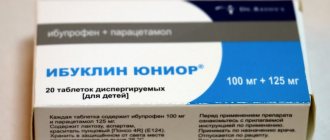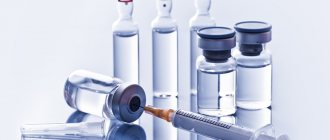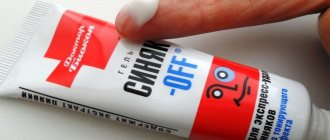The most common complaint from patients is pain. They can be anywhere - in bones, joints or muscles. Most often this happens to older people. But in the twenty-first century, pain as a symptom is “younger” and is increasingly found among young people.
Pain is a natural reaction of the body. It is a kind of alarm signal about the state of health. It is sometimes extremely difficult to independently determine the cause of pain, which means it is better to immediately go to the doctor.
Painkiller injections
In this article we will talk in detail about the nature of pain and what effective pain-relieving injections are available to help quickly get rid of discomfort.
About pain
Pain is an extremely unpleasant sensation. Pain as a phenomenon cannot be limited only to the concepts of an organic or functional disorder that is located at the site of injury.
Pain affects not only the location of the lesion, but also the activity of the body as a whole. This is confirmed by numerous studies on the consequences of such discomfort.
Pain is the most common and at the same time the most dangerous symptom that can occur in a sick person.
Pain is an integrative function of the body, which is characterized by psychological and emotional changes. It is she who is responsible for mobilizing the body’s defense systems from the effects of negative factors.
There are two types of pain:
- acute;
- chronic.
Acute pain is a reaction to an external stimulus. The reaction manifests itself due to the delivery of an impulse through nerve channels to the brain. It is transmitted, and then, as it were, returns to the source of the lesion.
Acute pain appears due to damage in the form of fractures of any bone, muscle or ligament sprains, injuries, caries, as well as various diseases of the internal organs. As a rule, this type of pain is treated well with painkillers (analgesics).
Chronic pain is more complex, and the causes of its occurrence need to be carefully studied. As a rule, this type of pain indicates difficulties in treating an injury or disease. It always drags on for more than six months. There is a connection between chronic pain and serious diseases, such as:
Side effects
The risk of developing serious complications when using such drugs is high:
- dyspepsia, nausea, pain, heaviness in the epigastrium, flatulence, unstable stool due to blockade of the special enzyme COX-1, which regulates the balance of hydrochloric acid and mucus;
- erosive processes on the mucous membrane of the digestive tract (the reason is the same);
- the risk of thrombosis (atherosclerosis, diabetes mellitus) provokes the development of heart attack, stroke, pulmonary embolism, peripheral thrombosis;
- the formation of renal failure due to impaired blood flow inside the kidney, water retention in the body, pastosity, swelling of the extremities, risk of CN;
- photodermatosis due to increased sensitization to sunlight, rash, bronchospasm, liver dysfunction, neurological disorders, vertigo, facial neuritis, alopecia;
- leukopenia is a life-threatening complication that occurs rarely with long-term use of Analgin and its derivatives;
- the risk of cancer growth, since many painkillers in the stomach can interact with each other, forming carcinogens (another reason to take medications only as prescribed by a doctor);
- nosebleeds (in children - Reye's syndrome) are caused by aspirin due to blood thinning and increased permeability of the vascular wall;
- NSAIDs (NSAIDs) have a negative effect on vision.
In order to minimize side effects, you need to be able to choose the right pain reliever; there are a few simple rules:
- If you need to relieve an attack of mild or moderate pain, Nurofen is suitable (there is a children's version);
- severe pain is relieved with Promedol, the drug is even used in obstetrics due to its maximum effect and relative safety;
- a strong painkiller without a prescription is Ketanov, which also has an anti-inflammatory effect;
- all-rounder for severe acute and chronic pain, including cancer - Tramadol (using a medicine with minimal pain is like shooting sparrows from a cannon);
- pain of moderate intensity is well relieved by Dexalgin tablets;
- Among opioid analgesics, it is better to give preference to Butorphanol;
- for injuries, operations, childbirth - the drug of choice is Diclofenac;
- colic, intestinal spasms, mild or moderate neuralgia are relieved by Bral (it is allowed from 3 months).
However, your doctor will always give you the most reliable advice.
About drugs
Any physical suffering leads to a person’s desire to get rid of it as soon as possible. For this reason, the patient’s course is a nearby pharmacy, where he looks for a medicine that can quickly and effectively relieve this kind of torment. But he faces the problem of a wide range of products. Today there are so many medications that sometimes it takes a lot of time to find the right one.
Medicines are mainly divided into two groups:
- non-narcotic;
- narcotic.
The latter include morphine and codeine. They are generally considered opioid drugs.
Medicines are the main helpers in the fight against discomfort
Narcotic types of drugs can be found in pharmacies under the following names:
- "Ethylmorphine";
- "Nabulfin";
- "Omnopon";
- "Morphilong";
- "Promedol";
- "Tramadol".
Medicines are most often produced in the following forms:
- tinctures;
- ointments;
- gels;
- solutions for injections;
- plasters.
The most convenient form for medications is tablets. Their advantages are the following:
- ease of use;
- no reactions from the body (no redness or itching);
- no need for syringes;
- It is not necessary to ask for help from qualified personnel (than when administering injections).
The anesthesia procedure is an obligatory part of the treatment. This is how partial or complete recovery from pain occurs. Its implementation depends on the cause of the pain and its severity. If the cause is any disease, then pain relief during complex stages of the disease is vital. If the tablets are ineffective, injections are prescribed - intramuscular or intravenous.
Analgesics help make life easier
So, in medicine, there are many different types of pain medications.
Choice of pain medications
For chronic types of pain, the physician must first determine the underlying causes and nature of the pain (whether the pain is referred, neuropathic, or central). Only after this can he prescribe a suitable course of treatment with an anesthetic drug.
In case of acute pain, the doctor must determine the possible risk of side effects on the gastrointestinal tract and cardiovascular system. If there is no dyspepsia, then any non-steroidal anti-inflammatory drugs are allowed to be used, but if there is, you should take Ibuprofen. You can also take Diclofenac, Naproxen, Nimesulide or Meloxicam as an alternative.
If you have heart problems, the patient should stop taking non-steroidal anti-inflammatory drugs and turn their attention to opioid drugs, as well as paracetamol. If the risk is moderate, then the patient is prescribed Nimesulide, but on the condition that blood pressure is at the normal level or can be brought to this level or any other drug to lower blood pressure.
Choosing pain medications is a complex procedure because there are so many factors to consider
If there is a high probability of bleeding in the gastrointestinal tract, the patient should take non-steroidal anti-inflammatory drugs together with proton pump inhibitors. Such inhibitors primarily include Omeprazole. It's all about the risk of bleeding when taking NSAIDs. In order to reduce or prevent it, their use is allowed only in combination with proton pump inhibitors.
If there is a high probability of simultaneous occurrence of complications associated with the cardiovascular system and the gastrointestinal tract, the patient is required to take Nimesulide together with acetylsalicylic acid and the proton pump inhibitor Omeprazole.
If the pain subsides within a week, then treatment should be continued until the discomfort is completely relieved. When this does not happen, the patient should use muscle relaxants and local anesthetics.
The administration of corticosteroids (hormonal drugs) is allowed only if it is confirmed that the patient does not have any signs of developing tuberculosis of the joints or spine.
Note! If the patient has very severe pain, but the drugs have no effect, then the problem is in the nature of the disease. In such a situation, as a rule, there is a high probability of a non-infectious nature of the pain.
Top 11 painkillers in tablets
Painkillers help with headaches, toothaches, injuries, and inflammation. They should be in every home medicine cabinet:
- Ketanov is one of the best prescription painkillers from the NSAID group based on ketorolac. Ketanov tablets are used for almost all types of acute pain syndrome. The indisputable advantage of the drug is its anti-inflammatory effect and ease of administration. Among the disadvantages are many side effects. Cost from 50 rubles.
- Nurofen - the active ingredient ibuprofen, has analgesic, anti-inflammatory, antipyretic effects. The drug of choice for colds, the downside is that it is addictive with constant use, it does not act immediately, it must take at least an hour. (from 75 rubles)
- Diclofenac is a drug used to treat joints and injuries. Diclofenac tablets have a strong anti-inflammatory effect, the downside is that the effect is short-lived. (from 25 rubles)
- Nise is a universal pain reliever, it is effective for all types of pain for at least 12 hours, the minus is that it causes drowsiness, you should not drive. (from 150 rubles)
- Paracetamol is an aniline derivative drug that has a pronounced antipyretic effect and minimal anti-inflammatory effect. Paracetamol is safe and recommended even for pregnant women and children. (from 15 rubles)
- Aspirin is an inexpensive drug that has the usual triad of NSAIDs: analgesic, antipyretic, and anti-inflammatory. Aspirin tablets are effective for colds, the minus is many side effects and the age of use is after 15 years. (from 75 rubles)
- No-spa (analogs of the drug Spasmol, Drotaverine) is a muscle antispasmodic, eliminates spasms without masking appendicitis and other acute surgical conditions, but does not have any other properties. (from 50 rubles)
- Citramon is a combination drug that can relieve pain, fever, and inflammation. Citramon - tones the entire body, can increase blood pressure, many side effects. (from 20 rubles)
- Movalis is a powerful latest generation pain reliever based on meloxicam. Movalis has anti-inflammatory, analgesic and antipyretic effects. There are practically no side effects, it is allowed from 15 years of age. The downside is that it is expensive considering the duration of the course of treatment. (from 500 rubles)
- Novigan is a universal pain reliever, relieves headaches, including migraine, the drug is effective for painful periods, symptomatic treatment for joint pain, neuralgia, sciatica, myalgia. The medicine acts quickly, but has many contraindications. (from 130 rubles)
- Bral - the drug has 3 active components: pitophenol (myotropic effect), metamizole sodium (reduces pain, temperature), fenpiverinium bromide (relaxes smooth muscles). Bral tablets are used to relieve moderate pain of any etiology, for diseases of the nervous system, and to relieve spasms after operations. (from 75 rubles)
How to give an intramuscular injection correctly
When choosing a place to administer an injection, the following places are searched:
- where injections have already been given (there are seals there);
- hemangiomas;
- moles;
- prominent capillaries.
It is prohibited to inject into such places.
To make an intramuscular injection without harming yourself, you need to perform the following manipulations.
- Wash your hands with laundry or any other soap. This is important because your hands, and especially the area under your nails, are where the most germs accumulate. Girls who have long manicured nails need to wash the area under them with a special brush.
- Prepare three cotton pads.
- Moisten the first cotton pad with an antiseptic and wipe your hands as thoroughly as possible.
- Take out the package containing the syringe. Open it. Be careful not to touch the needle during assembly.
- Take an ampoule with injection solution. Using a second cotton pad, which is also moistened with an antiseptic, take the top of the ampoule and break it. You can do it differently - if you have a special file in the kit, use it to file down the top of the ampoule.
- Remove the assembled syringe from the package. Remove the cap from the needle. Insert the needle into the ampoule itself (you must try not to touch the walls and bottom). In this way, draw up the medicine, and then get rid of the air inside the syringe by gently pressing the piston.
- Take a third cotton pad. They need to clean the area where the injection will be given. The place can be marked in advance with iodine - this will make it easier to get where you need to go.
- The hand needs to be pulled back, but not much. Then the injection is given.
- At the end of the procedure, remove the needle from the injection site. Then take a cotton pad and press it harder to the needle insertion site. Hold for a minute.
Each time you need to change the injection site to avoid the formation of seals. It is recommended to paint the mesh with iodine - this way you can achieve disinfection and warm up the area.
It is worth noting a separate case in this instruction. If the medicine is in powder form, one additional step is required. In addition to the fact that the ampoule with the solution needs to be opened, the protective foil removed, and the cap disinfected, you need to add the medicine in powder form to the liquid and mix until smooth. Only after this can the resulting drug be injected into the syringe. Then proceed in accordance with the instructions.
Prevention
To prevent various types of pain in the back, lower back and other places associated with the musculoskeletal system, as well as to prevent pain in the internal organs, the following rules must be followed.
- Correctly get up, stand, walk, sit and lie down.
- Maintain proper posture when lifting and moving heavy objects.
- Exercise vigorously.
- Follow a strict diet and switch to a healthy diet.
- Monitor your psychological state and do not give rise to negative emotions.
Literature
- Kukushkin M.L., Tabeeva G.R., Podchufarova E.V. Pain syndrome: pathogenesis, clinical picture, treatment. Clinical recommendations / ed. acad. RAMS N.N. Yakhno. M.: IMA-press, 2011
- Maksimov M.L. Modern approaches to the treatment of pain // Russian Med. magazine. 2013. The place of muscle relaxants in the treatment of pain // Russian Medical Journal. 2014.
- Evseev M.A. Damage to the intestinal tube by non-steroidal anti-inflammatory drugs: clinical significance, pathogenesis, possibilities of prevention // Neurology, neuropsychiatry, psychosomatics. 2013. No. 1.
- Karateev A.E. On the way to creating a new generation of non-steroidal anti-inflammatory drugs: amtolmetin, guacil // Modern rheumatology. 2014. No. 2.
- Rainsford KD Current status of the therapeutic uses and actions of the preferential cyclo-oxygenase-2 NSAID, nimesulide // Inflammopharmacology. 2006
- Renard J., Julemont F., de Leval X., Pirotte B. The use of nimesulide and its analogues in cancer chemoprevention // Anticancer Agents Med Chem. 2006
- McEvoy GK AHFS Drug Information 2007. ed Tolmetin. Bethesda, MD: American Society of Health-System Pharmacists, 2007










